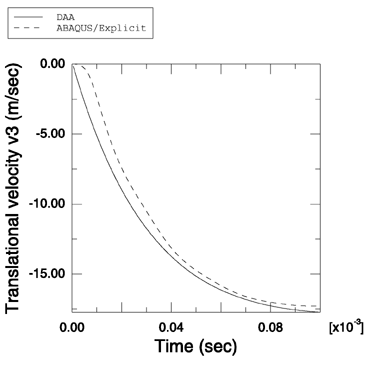Problem description
When an underwater explosion occurs, a compressive wave is generated. This wave can have a substantial effect on a submerged structure.
This problem models the interaction between an air-backed elastic plate and a weak planar exponentially decaying shock wave with a maximum pressure of 15.4 MPa and a decay time of 0.433 ms. In contrast to Taylor's solution, engineering material parameters for the fluid and solid media are used. The plate is a square of side 1 m and has a thickness of 0.00635 m. The plate is made of steel with a density of 7850 kg/m3, a Young's modulus of 210.0 GPa, and a Poisson's ratio of 0.3. The fluid is water with a density of 1000 kg/m3, in which the speed of sound is 1461 m/s. The plate is represented by a single S4R element, and the surrounding fluid is represented by a fluid region that extends from the plate to a distance of 5.5 m away from the plate in the direction of the incoming shock wave. The fluid region is modeled by a single stack of 400 AC3D8R elements. A planar nonreflective impedance boundary condition is imposed on the exterior surface of the fluid region furthest from the plate. The fluid response is coupled to that of the structure using a tie constraint on the fluid surface nearest to the plate and the plate itself. The fluid-solid system is excited by a planar exponentially decaying wave applied at the fluid-solid interface using incident wave loading. In addition, the plate motion is constrained by the use of four springs attached to the nodes of the plate, each possessing a spring constant of 4.919 MN/m. A linear bulk viscosity parameter of 0.25 and a quadratic bulk viscosity parameter of 10.0 are used.
